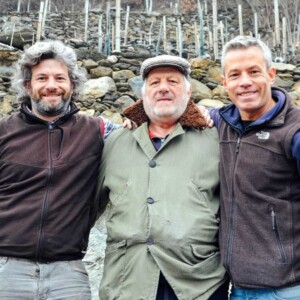Barbacan

Matteo, Angelo, and Luca Sega
About
Owners & winemakers: Angelo, Matteo, and Luca Sega
Vineyards: 9ha, all estate-owned
Vineyard management: Certified organic
Soils: Sandy, rich in minerals like silica and quartz
Grapes grown: Chiavennasca, plus ancient local varieties such as Róssolino, Treunasca, Pignóla, Brugnóla, Róssola, Negrera, Róssolino Rosa, Bressana, etc.
Annual production: 40-50,000 bottles
Quick facts:
- Brothers Matteo and Luca practice what’s referred to as “heroic viticulture” and it’s no exaggeration: they’re painstakingly using traditional techniques to care for old vines on impossibly steep slopes at 400-700m of elevation.
- Don’t call it Nebbiolo: in Valtellina the grape is known by its local name, Chiavennasca.
- Check out Barbacàn’s social media for a behind-the-scenes look at their heroic viticulture, plus lots of dancing.
Valtellina is an alpine valley nestled between the Bergamo Alps and the Rhaetian Alps, not far from the border with Switzerland. The family behind Barbacàn has been cultivating vineyards and making wine in this region for at least six generations, managing upheavals from the arrival of phylloxera to the collapse of the Swiss market (historically the main outlet for Valtellina wines), plus all of the other major socio-political changes that have swept Italy and Europe in the last two hundred years. Domenico Pedrotti, Luca and Matteo’s great-great-great-grandfather, was the first to produce wine commercially in the mid-1800s, continuing the legacy of his father, who was cultivating vineyards and producing unbottled wine for local consumption. The Barbacàn estate has been passed down through the family ever since. Angelo Sega took the reins in 1976, guiding the project through the difficult 1980s, and with the help of his wife Marinella and sons Luca and Matteo, he slowly grew the property to its current size of 9ha. Since 2011, Angelo has progressively left the day-to-day management of Barbacàn to his sons, while continuing to give important advice in the vineyard and the cellar.
The Barbacàn vineyards are distinctive for two main reasons: the altitude–they have plantings between 400m and 700m above sea level, with slopes up to 30%–and the incredible dry stone terraces that make it possible to farm these mountains. “We’re talking about a thousand-year old tradition of viticulture with ancient origins, that for centuries exported wine to all of central Europe, consisting of thousands of tiny plots rooted on the mountain,” Luca explains. “Up here, mankind has adapted to the harshness of the mountains with a grandiose architectural achievement: millions of stones, one on top of another, that form a multitude of dry stone walls resting on top of the living rock.” Throughout Valtellina, there are around 2500 km of these stone terraces.
These terraced vineyards are planted to many different indigenous grape varieties: Chiavennasca, the local name for Nebbiolo, makes up the largest component, but it’s interspersed with vines of a dozen other ancient local varieties. “Having many different varieties, all strictly autochthonous, in the same vineyard, reduces the impact of disease and makes us the guardians of a formidable patrimony of biodiversity, inherited from our ancestors to be passed onto our children,” Luca explains. Despite the difficult conditions, their careful work means that the vines are very long-lived, with a number of plants over 100 years old.
Unsurprisingly, all of the vineyard work at these sites needs to be done by hand. “Up here, there’s still no machine that can replace human tenacity,” Luca affirms. “It’s a type of viticulture in which the human component is central and irreplaceable.” In the spring, they can be found hand-tying each vine with willow shoots in the traditional “archetto valtellinese” pruning system. In the fall, all of the grapes are harvested by hand into tiny baskets and then carried back up the mountain. It’s no exaggeration to call this work “heroic viticulture.”
“The main difficulty of practicing natural viticulture like we do is finding partners to work alongside us everyday on the front lines, willing to do the increased physical labor required by this natural and heroic approach,” Luca tells us. “Fortunately over the years we have established a young and close-knit team that has fully embraced our philosophy, bringing new enthusiasm and ideas.”
In the cellar, the work is hands off, respecting the traditions of the family. “We learned to make wine from our father, who learned from his father, and so on and so forth,” Luca explains. “For us, the wine must be produced from fermented grapes and that’s it.” The wines are fermented spontaneously with native yeasts, then aged in large oak botti, amphoras, cement, or stainless steel tanks. No sulfur is added during fermentation or aging, and only a small dose is added at bottling if needed.

